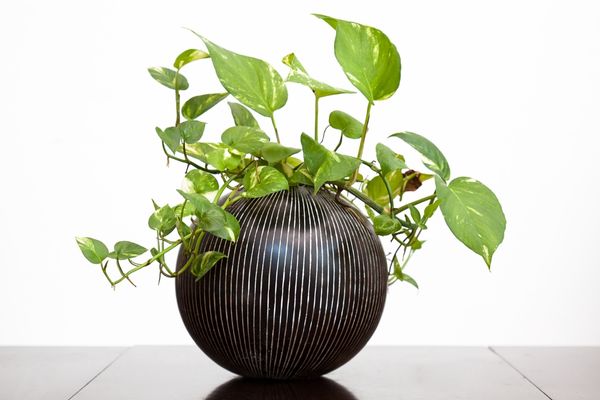
Table of Content
If you are looking for a new indoor plant that would not only add a natural effect to your sitting area or boring workplace but also catch the eye of every visitor, then pothos is the right plant for you! With their heart-shaped leaves variegated with tints of white, pale green, or yellow, they are a popular indoor plant that would grow easily with little maintenance. You can even grow pothos indoors without soil.
There are many different pothos varieties, mostly distinguished by the leaf color and shape. Some of these varieties require a large supply of direct sunlight and should be grown outdoors, while some prove to be the best plants for indoor settings. Let’s take a look at the types of pothos you can grow indoors.
These are 7 very popular varieties of pothos that can be grown indoors. These include the following:
- Golden pothos
- Manjula pothos
- Pearls and Jade pothos
- Marble Queen pothos
- Neon pothos
- Jessenia pothos
- Glacier pothos
Here’s a look at the distinctive features of each type and tips on how to make them grow better.
Golden Pothos

Being a very popular type of pothos, golden pothos features distinctively heart-shaped green leaves having splashes of cream yellow or cream golden. This variety is so popular because it grows easily and needs very little maintenance. Plus, you can simply pluck a stem from a golden pothos plant and grow your own plant.
Distinctive feature: Emerald green heart-shaped leaves with splashes of creamy yellow
Tips for better growth: This variety needs bright, indirect sunlight to grow to its fullest. Place the plant on a shelf or on top of a cupboard, for the trailing vine to beautifully hang down. For better growth results, give the plant some fresh outdoor air in the summer.
Pros: They need little maintenance and can grow on their own with little care. They are an easy plant for people starting to grow indoor plants.
Cons: To grow properly, they require a bundle of bright, but indirect sunlight to grow properly. A lack of this can result in the leaves becoming entirely green and losing their splashes of cream gold.
Manjula Pothos
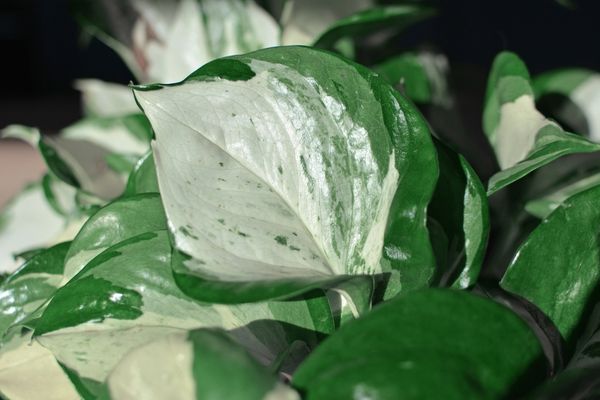
Manjula pothos comes with large, heart-shaped leaves that are abstractly colored. The marbled leaf colors range from white to green through silver and cream. The peculiar leaf shape distinguishes Manjula pothos from other pothos varieties, they are wide and curved at the edges, rather than flat.
Distinctive feature: Heart-shaped wide leaves that are curved around the tips and have wavy edges
Tips for better growth: Avoid exposing Manjula pothos to direct sunlight for a long time and overwatering the plant. A balanced amount of water and ample indirect sunlight shows the best growth results.
Pros: When placed against a neutral wall, or in a formal or modern setting, it adds an abstract painting effect to the place.
Cons: It is pricey and not easy to find as compared to other varieties. If exposed to too much sunlight or if it receives too little sunlight, then the leaves lose their balance between light and dark colors.
Pearls and Jade Pothos
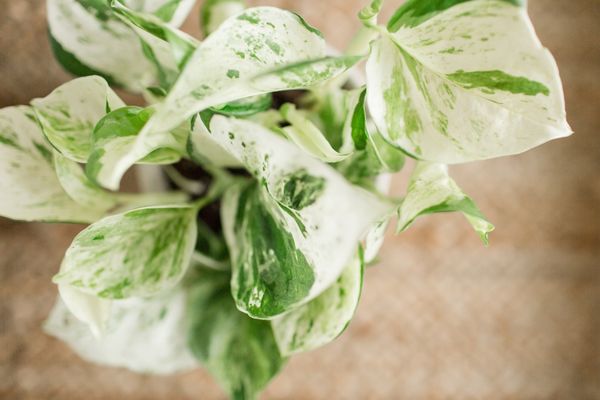
Also called Snow Queen Pothos, the Pearls and Jade pothos comes with beautifully textured leaves with white variegations in wide streaks and patches. The green tone of the leaves is stunning, going from very bright green to intense and dark green.
Distinctive feature: White and cream variegations on jade green leaves.
Tips for better growth: Expose the plant to bright, indirect sunlight to keep the white streaks and to prevent the leaves from becoming medium green.
Pros: Grows quickly
Cons: The green color in leaves become darker and spreads over the white if placed in places with low or no direct sunlight.
Marble Queen Pothos
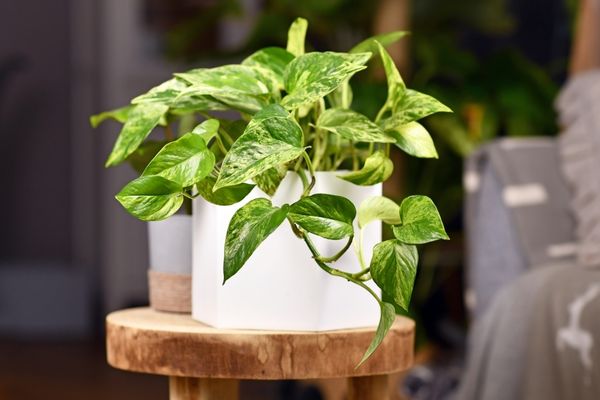
Another very popular type of pothos is the Marble queen pothos. The plant has low levels of chlorophyll, so it grows slowly and is a good indoor pothos variety to place at the center of the table. The leaves have patches of white and green, resembling marbles, thus giving this plant its name.
Distinctive feature: Leaves have patches of white and green, sometimes the green dominating the white and vice versa.
Tips for better growth: Having little chlorophyll, this variety shows slow growth. It looks nice if you put a pot of marble queen pothos indoors on top of a table instead of a shelf. Be careful with the sunlight the plant receives. Excess or too little light can both be damaging to the plant.
Pros: The slow-growing marble queen pothos needs little maintenance and doesn’t grow out of its pot.
Cons: If the plant receives a lot of sunlight it starts to make chlorophyll. This results in the leaves losing their white color and becoming purely green. The leaves can scorch and bleach if placed in direct and strong sunlight.
Neon Pothos
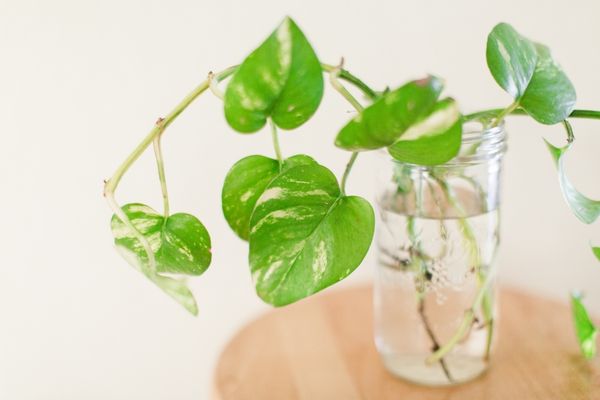
Neon photos have the best heart-shaped leaves among the different pothos varieties. The leaves are of bright shiny green color and belong to monochrome types of pothos. Neon photos are so popular since the shape and color of leaves are both perfect, making an ideal indoor pothos plant to place on an office desk or a sculpturally furnished room.
Distinctive feature: The leaves are perfectly heart-shaped and bright green in color, with no shades of other colors
Tips for better growth: Avoid overwatering the Neon pothos, as the roots get damaged if they are kept in soggy soil for a long time.
Pros: New plants easily grow from stem cuttings of the previous plants
Cons: When they receive little sunlight, the leaves become duller and darker and don’t reach the neon green color.
Jessenia Pothos
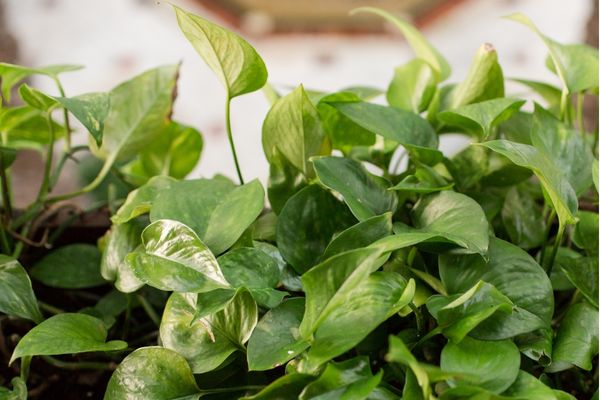
Jessenia pothos has a variegation pattern quite the same as that of the Marble green Pothos. The difference is that the leaves of Jessenia pothos are variegated with splashes of two colors, dark emerald, and chartreuse. The leaves are not glossy and smooth like that of other types of pothos, but are rather textured and have visible veins.
Distinctive feature: The leaves are shaped as ovals and are more textured with prominent veins. The leaves are densely packed on the stem.
Tips for better growth: Although Jessenia is not a fast-growing pothos, to prevent the plant from slowing down its average rate, it is important to provide optimal temperature, humidity, and bright light.
Never expose the plant to excess direct sunlight and extreme temperatures. The variegation fades away if kept in places with low light and stays prominent in bright light. Overwatering can ultimately kill the plant, so water it carefully.
Pros: Leaf color is stable, so you can place it in places with varying light conditions.
Cons: Overwatering and exposure to direct sunlight can kill the plant.
Glacier Pothos
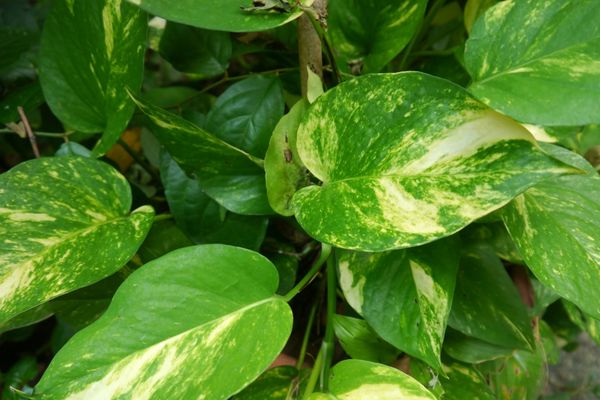
Glacier pothos is becoming popular as indoor plants because of some striking features. Firstly, they stay small and compact, thus making a great addition to office desks, shop counters, or coffee tables. The beautiful color patterns on the leaves are the most distinct feature of glacier pothos, as they have patches of cream white and emerald green.
Distinctive feature: The small leaves have broad, well-defined patches of cream-white and emerald green.
Tips for better growth: Trim the plant from time to time to retain a fuller and denser one. Keep it in places with bright, indirect sunlight to maintain the balanced composition of the leaf colors
Pros: The small size of glacier pothos make them the best plant to place on formal settings, on table tops, and on counters.
Cons: Not a plant to place in a high basked or on top of a cupboard. The white and green composition of the leaves becomes disturbed if placed in low-light settings
Wrapping Up
Pothos constitute a great indoor plant variety, with many types of pothos requiring minimum maintenance. Not just a classic addition to a dull room or a boring office, but they also work as air purifiers. Knowing about the different pothos varieties and tips to grow them makes it easier for you to grow indoor pothos.






